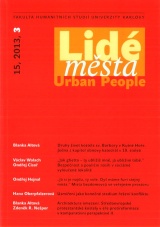The Resurrection of St. Barbara’s Church in Kutná Hora
A Chapter in the Cathedrals‘ Renovation in the 19th Century
DOI:
https://doi.org/10.14712/12128112.3468Keywords:
Kutná Hora - Church of St. Barbara, cathedral renovation, historism, nationalismAbstract
At the time when images are transferred physically, as well as virtually, in time and space and are used in new contexts, we tend to perceive buildings as static images or permanent artifacts, and some of them are even set as symbols for their durability in time and space. Namely, they stand amidst the movement caused by the human need for narration. In the chapter In the Search of Not Quite Lost Time, N. N. Taleb (2011, 87–88) writes: “Our tendency to perceive – more precisely, to introduce – narrative structure and causality are a symptom of the same disease: reduction in the number of dimensions.” Reduction of the narration of the past occurs, according to Taleb, either because of our inability to remember the actual plot or because we tend to interpret past events in our own favor. Both of these general observations can (must) be applied to history, and history can be seen as a reduction of the past carried out by the historian while being determined by the objectives of constructing causal connections based on available and understandable sources. The French psychologist and historian Michele de Certeau (1925–1986) writes about the power of the narrative act, which he already observes in the descriptive text (which precedes the interpretation): “Description is a culturally creative act, it has distributive power and performative strength” (Certeau, 1996, 88). So we have many reasons to accept that the texts of historians are not innocent and cannot be objectively valid, but they represent powerful forces with more-or-less hidden individual, as well as collective, goals. In this study, I follow the use of historical narratives – arguments used in the political discourse of the 19th century with an implicit objective: to raise funds for the restoration and the extension of St. Barbara’s Church in Kutná Hora, both from the budget of the Austrian Empire and from the Provincial Assembly of the Bohemian Kingdom. This political effort reflected the process of Czech national emancipation within the Habsburg monarchy in the period of European historicism. One must admit that despite a number of substantive and conceptual reservations about these texts today, these historical and political narratives have enabled St. Barbara’s Church its significance, have kept it in religious service and in historical memory and consciousness, and have placed it on the national and world maps of art and cultural heritage. These narrations have had an undeniable impact on the practical implementation of the restoration work, i.e. what should be preserved from the past of the church and how, what should be added and what should be removed. Based on this example, it is possible to realize how narrations, for better or worse, have shaped and still shape our ideas of Czech and European identity and what affects our relationship to the nation and Europe.
Downloads
Published
How to Cite
Issue
Section
License

This work is licensed under a Creative Commons Attribution-NonCommercial-NoDerivatives 4.0 International License.



